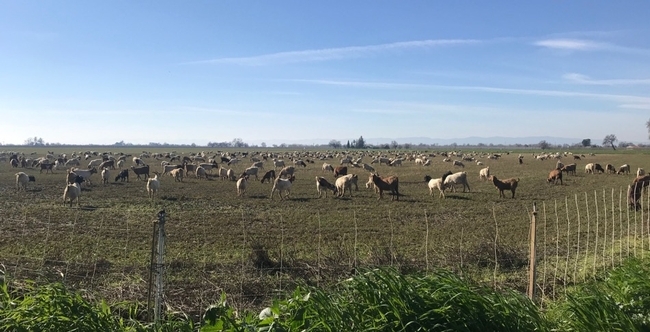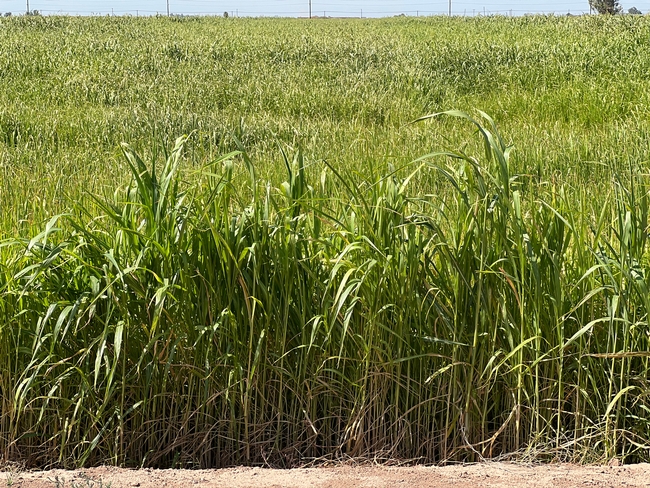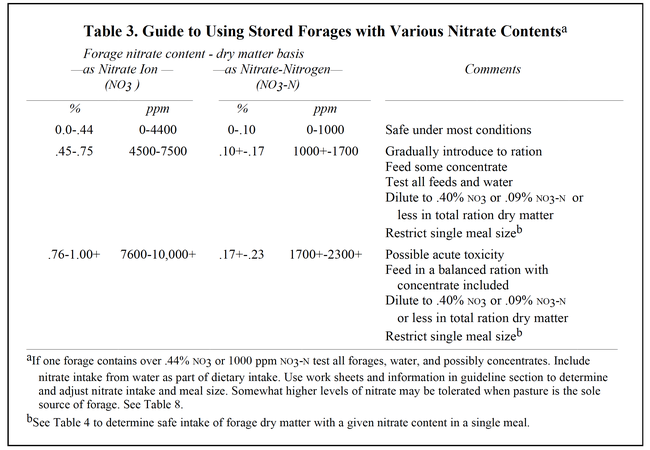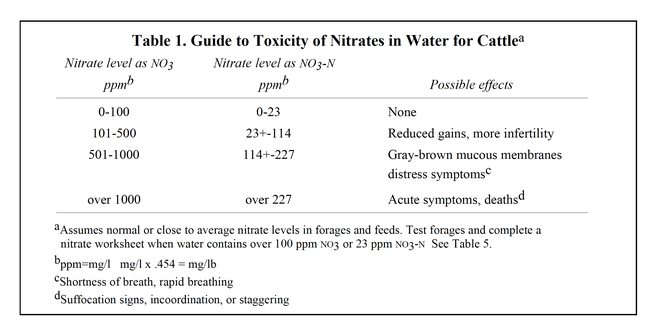Sudangrass (Sorghum bicolor L.) is a type of sorghum which is widely grown for hay, greenchop or grazing systems. Typically over 50,000 acres of sudangrass are grown for hay in the Imperial Valley of California, much of it exported to Japan.
However, sudangrass (and sudan-sorghum hybrids) can be grazed or fed as greenchop to livestock particularly beef animals or used as a vigorous cover crop. What are the risks of feeding sudangrass to livestock?
Is Grazing Safe? A couple of questions have come up about grazing sudangrass including: 1) grazing sudangrass stubble after harvest, and 2) grazing sudangrass in a cover crop. Is this a safe practice? Maybe, but pay attention! Care is needed when utilizing these forages for cattle, sheep, and goats because of risks related to prussic acid (hydrogen cyanide) and nitrate poisoning. Forages in the sorghum family should never be fed to horses because of risk of a poorly understood but sometimes fatal condition causing loss of coordination, fetal deformities and severe bladder inflammation.
What is sudangrass? Sudangrass, forage sorghum, and sorghum-sudangrass hybrids are warm season annual grasses that are exceptionally heat and drought tolerant annual crops used for hay, green chop, silage, and grazing. Increasingly these forage crops are being planted in California and other western states where water is limiting to help satisfy local and export markets. Both sorghum and sudangrass are varieties of Sorghum bicolor L. Sudangrass is a 'hay type' sorghum, while sorghum has larger leaves and is primarily utilized as a silage crop. A range of sorghum/sudangrass crosses (also called Sudex) are planted as annual forage and grazing crops. These are our most productive summer annual forages; sudangrass readily dries down for baling, with 2-4 cuts per year, yielding 5 to 8 tons per acre.

What are the livestock risks? Both sorghum and sudangrass represent risks to livestock producers. The risks are from either nitrate accumulation (nitrate converts to nitrite in the rumen, enters the bloodstream and prevents oxygen transfer by hemoglobin) or prussic acid. Prussic acid is also known as hydrogen cyanide and its accumulation causes cyanide poisoning. The largest risks for these two factors are when the crop is under water stress along with excess nitrogen in the soil, such as residual nitrogen from prior crops or heavy manure applications from dairies, or when the crop has been frosted in the fall. Water stress prevents metabolic conversion of nitrate taken up through the roots to protein, with nitrates accumulating in the lower stems. Frost also results in the accumulation of prussic acid especially in young plants. Leafy sorghum are especially a problem, with leaves containing more toxin than stems.
There have been a number of cases of sudangrass hay killing livestock over the years. Nitrate poisoning is more of a risk in our California dry environment than prussic acid, although the later does occur. Sorghum and sudangrass are 'famous' nitrate accumulators, as are weeds such as lambsquarters and pigweed. One of the largest disasters in California was the killing of about 60 cows on an organic alfalfa field which had a lot of pigweed and lambsquarters (normally palatable) that was green chopped and fed directly.
Nitrate management. Nitrate accumulation is caused by factors that limit photosynthesis and the conversion of nitrate to nitrite, such as water stress, less sunlight on a cloudy day, plant diseases, frost, and excess nitrogen when fertilizing crops (as might occur from manure applications from dairy sludge). Monitoring and plant testing (lower stem) for nitrate is recommended and growers should watch out for water stressed conditions and be especially careful of other stresses to plants and photosynthesis. Animals can adapt to high-nitrate forages (>9000 ppm nitrate) by gradually increasing such feeds into their diet. Forages for pregnant ruminants should not contain more than 2000 ppm nitrate and even feeds with less than 1000 ppm nitrate can be lethal to hungry animals that quickly consume too much total nitrate. Send plant samples to a lab for analysis or use a quick nitrate test kit to be sure that nitrate levels are low to protect livestock from nitrate toxicity. Keep in mind that nitrate concentrations in plants can vary widely across a field making some areas safe and other areas hazardous to livestock.
The nitrate concentration of the whole diet must be considered including other feeds that might contain nitrate, as well as high nitrate in the drinking water (which is common). Important to test!!
Prussic acid management. Although rare in California, prussic acid or cyanide poisoning can be caused by all sorghum varieties. Prussic acid poisoning is caused by a secondary compound called dhurrin in the plant cells that is converted to prussic acid upon wilting, chewing, frost or other factors that stress or rupture plant cells. Young, rapidly growing plants have high dhurrin concentrations, with the highest levels in newly germinated seeds. Prussic acid poisoning risk declines as the plants mature, but environmental factors that force new regrowth can increase dhurrin concentrations to dangerous levels. Because of the higher dhurrin concentration in new leaves, sorghum forages should never be grazed or fed as green chop until plants are at least 18 to 24 inches tall. When a killing frost is expected, animals should be removed from the pasture until the frost-killed plants are completely dried (usually 5-6 days). If new shoots form after frost, animals should not be allowed to graze until the new shoots are 18 to 24 inches tall, because they may preferentially graze the new growth which will be high in prussic acid. When sorghum-family forages are cut for hay, prussic acid dissipates as the hay dries, and hays are safe to feed once bales have reached the stable storage phase. Cyanide testing of forages is available.
Overall thoughts on grazing sudangrass. Generally, well-watered and not wilted, sudangrass or sorghum taller than about 20-in should be safe for grazing. However, because many environmental, animal behavior and animal physiological factors influence the risk of intoxication, testing is recommended to protect animal health. Of the sorghum species and varieties, sudangrass is safer for prussic acid risk, but not immune! For example, Piper sudangrass is noted for its lower prussic acid content but is still a risk for livestock nitrate toxicity problems. In addition, pay attention to potential nitrates in drinking water that might increase exposure of livestock to nitrate toxicity. For this reason, we include tables that give some ranges on safe and conditional tolerance levels of nitrates in water and forages (see tables below from Adams et al.).


Additional reading
Adams RS, TR McCarty, and LJ Hutchinson. Prevention and control of nitrate toxicity in cattle. https://dairy-cattle.extension.org/prevention-and-control-of-nitrate-toxicity-in-cattle/
Cassida K. Sorghum-sudangrass pasture poses prussic acid and nitrate poisoning risk. https://forage.msu.edu/extension/sorghum-sudangrass-pasture-poses-prussic-acid-and-nitrate-poisoning-risk/
Vough L. Preventing prussic acid poisoning of livestock. https://forages.oregonstate.edu/fi/topics/pasturesandgrazing/grazingsystemdesign/preventingprussicacidpoisening